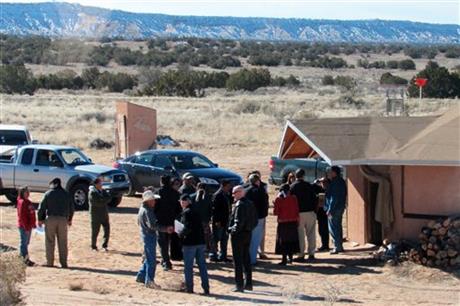
By FELICIA FONSECA
The rolling hills of northeastern Arizona where cornfields lined a watering hole and sheep grazed in the distance were home to Susie Robinson and her extended family. When she moved farther east into a new four-bedroom home, it wasn’t by choice but the result of a bitter land dispute between the Navajo and Hopi tribes that dates back centuries.
The federal government’s attempt to have these tribes share land failed miserably, leading to one of the largest single relocation efforts in U.S. history. Thousands of Navajos have been transplanted into new homes off Hopi land, while dozens of Hopis have been moved off Navajo land.
Federal officials are trying to figure out how best to wrap up the work of the relocation program that has exceeded its original $41 million price tag by more than $500 million and dragged on decades longer than planned. The effort threatens to get even costlier with many people still awaiting new housing.
“I want to move this forward,” said Republican U.S. Rep. Ken Calvert of California, who recently visited the reservations with other congressional delegates to hear from tribal leaders on the matter. “The relocation program was never intended to be carried on in perpetuity.”
The Office of Navajo-Hopi Indian Relocation was established by Congress in the years after the neighboring tribes were assigned reservations. It underlines a history of animosity between the Navajo and Hopi that has included threats of violence over property and clashes over cultural, business and political views.
Land is the most contentious issue.
The Navajo and Hopi tribes have occupied the same territory for centuries, though Navajos tended to be more nomadic sheepherders and Hopis mostly resided on three mesas towering above the surrounding desert.
In 1882, President Chester Arthur designated 2.4 million acres in Arizona for the Hopi Tribe and other Indians. Hopis outnumbered Navajos six to one on the land, but the Navajo population grew over time.
The federal government later gave the tribes the OK to sue over the land, and the Hopis responded in 1958 by seeking sole control of it. Four years later, a federal court deemed 1.8 million acres a joint-use area.
But the tribes were not amenable to sharing the land and, ultimately, Congress divided it and ordered tribal members to leave each other’s reservations. The Navajo Nation — the country’s largest reservation at 27,000 square miles — now completely surrounds the 2,500-square-mile Hopi reservation.
When the federal government proposed relocation, some Navajos armed themselves and threatened bloodshed if anyone tried to move them.
About a handful of Navajos who refused to leave Hopi land still live there under Hopi jurisdiction. Tensions run high at times, particularly over livestock grazing. The Hopi Tribe seized sheep from Navajos last year to preserve the vegetation.
The two tribes also have clashed in other areas. Until recently, they refused to be in the same congressional district. The Hopi Tribe also has been fighting a proposal for the Navajo Nation to build an aerial tram into the Grand Canyon.
“The relocation basically was a very traumatic experience for Navajo families who were directly affected,” Navajo lawmaker Walter Phelps said. “But it was also a very traumatic experience politically that has a certain amount of impact on the relationship between the tribes and the federal government.”
Still, the relocation program mushroomed, with the number of people eligible for housing benefits almost four times higher than expected.
In all, more than 7,200 heads of household have sought relocation benefits, representing 16,386 people. The relocation office has approved more than half of those applications.
The program was slated to end in 1986, but Navajo opposition to relocation early on and a shortage of suitable land to build houses helped prolong it.
Today, about 120 Navajos still await homes, 300 administrative appeals are pending, and eligibility is being determined on 65 applications, according to a recent report from the Interior Department’s Office of Inspector General. The program’s cost could go up another $35 million to $82 million once those applications and appeals are settled.
Robinson moved into her new, stucco house on a 1-acre plot in 1985. It was much larger than the two-room house she shared with her mother growing up. But the windows, foundation and stucco started cracking within a year, and she doesn’t have the sheep, cornfields, watering holes or ceremonial hogan she had as a child.
For Robinson, the relocation house isn’t home.
“I still miss my old place,” said the 60-year-old teacher who works with special education students at a school on the Hopi reservation. “If I were to get that piece of land back, I would be there in a heartbeat.”
About a dozen Hopi families relocated to a community called Spider Mound on the Hopi reservation. They have decried the lack of paved roads, running water, electricity and fire suppression that the Hopi chairman’s office said they were promised.
The delegation from the U.S. House Appropriations subcommittee that Calvert chairs said it saw an obvious need to address areas of disrepair but wasn’t sure that would be covered by the relocation program.
The relocation effort could be completed faster with legislative changes that could include a cash payout instead of a new home, or an increase in annual appropriations, the Office of Inspector General report said.
Democratic Rep. Ann Kirkpatrick, whose district includes the Navajo and Hopi reservations, said she would work with the subcommittee to ensure the federal government meets its obligation to the tribes.
“They heard from a lot of concerned people who are relocates who spoke very eloquently about their conditions of living and how desperate the situation is,” she said.



